Sleep Tight! Don't let the Bed Bugs Bite! Practical Information for Dealing With and Eliminating Bed Bugs
Guide G-324
Carol Sutherland and Alvaro Romero
College of Agricultural, Consumer and Environmental Sciences, New Mexico State University
Authors: Respectively, Extension Entomologist, Department of Extension Plant Sciences, csutherl@nmsu.edu; and Assistant Professor/Urban Entomologist, Department of Entomology, Plant Pathology, and Weed Science, aromero2@nmsu.edu, New Mexico State University. (Print Friendly PDF)
Introduction
In recent years, the common bed bug2 has shown that age, race, sex, national origin, current address, sleeping arrangements, quality of accommodations, and socioeconomic status do not affect its use of human blood as a food source. Growing global economies, ease of affordable travel, and increased insecticide resistance have likely contributed to bed bug redistribution and reappearance around the U.S. and elsewhere. With the development of effective, synthetic insecticides after World War II, these flightless bloodsuckers nearly disappeared from American dwellings. But now, hordes of insecticide-resistant, resilient bed bugs are surging back into not only beds of all shapes, sizes, and brands but also used furniture, used clothing, and even seats in theaters and mass transit in various parts of the country. In the last decade, bed bug infestations have been reported in all 50 U.S. states and many other countries. Further escalation of this public health problem should be expected.
Bed Bugs in History
If archaeologists and historical climatologists are correct, the common bed bug probably originated in the Middle East. Bed bugs may have switched hosts from bats and birds in caves to humans some 10,000 or more years ago when the area grew hotter and drier. With birds and bats leaving the area in pursuit of food, early humans were moving into caves, probably using fire to keep themselves warm and ward off predators. From the bed bug's perspective, humans were warm-blooded and nearly hairless; they probably returned to their caves regularly to sleep on pallets of dried grasses heaped with furry animal skins—perfect accommodations for the bugs. When the humans moved their few belongings, tiny bed bugs could easily hide in the furs, riding to new locations without missing a meal. Thus, an opportunistic, parasitic relationship may have begun, transcending the ups and downs of civilization, war, occupation, slavery, peace, poverty, trade, and travel. Desperate for a good night's sleep, bed bug-bitten humans developed various practices, potions, and poisons to battle the little pests. Historical accounts suggest bed bugs were in Europe by the time of the Greeks and early Romans, northern Europe by the 11th century, and North America by the mid-1700s, thanks to early sailors and colonists.
An escalation of bed bug infestations coincided with increased use of central heating in European and U.S. homes during the beginning of the 20th century. Bed bug infestations, particularly in poorer and overcrowded places, were a common issue in the U.S. during the 1930s and '40s. Numerous control methods were used to eliminate infestations, but with little success. A turning point in the history of bed bug control occurred after the advent of highly effective synthetic insecticides such as DDT in the mid-1940s, and subsequently organophosphates and carbamates. Particularly in developed countries, bed bugs nearly disappeared, with only sporadic infestations occurring in dwellings with high occupant turnover and questionable sanitary conditions.
By the early 2000s, bed bugs began a surprising resurgence into our modern society. They have starred in compelling, creepy stories and videos on local and national news. Publicity has led to increased public awareness, with bed bug "sightings" and infestations reported across the country. Bed bug infestations have been reported in almost all types of human-occupied structures and various means of mass transportation. While bed bug infestations occur across all social and economic classes, the most severe infestations often occur among the socially disadvantaged, including low-income minority communities. Cultural and language barriers, living conditions, and inability to afford effective pest control services are among the main reasons these social groups are particularly affected by bed bugs.
Description of the Common Bed Bug
The adult bed bug is a broadly oval, flat, rusty-brown, crawling, flightless insect that is barely 6 mm (<1/4 in.) long (Figure 1A). The small size and flatness of bed bugs allows them to fit in crevices or cracks in their environment, and it is in these harborages where they mate and aggregate (Figure 2). All immature stages and the adult have the piercing-sucking mouthparts characteristic of members of the order Hemiptera, the "true bugs." The forewings are reduced to oval, functionless flaps, while the hind wings are absent. Bed bugs are flattened and brown when unfed, but become swollen and elongated after feeding, turning reddish-brown (Figures 1A and 1B).
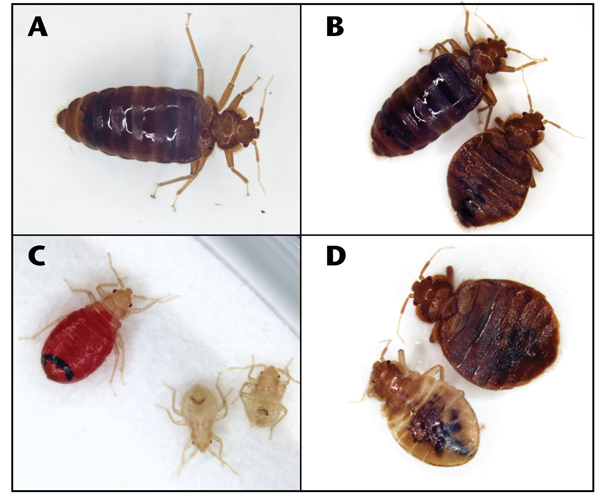
Figure 1. Different life stages of bed bugs: A, engorged adult male; B, engorged (left) and unengorged adult male (right); C, first-instar nymphs, engorged (left) and unengorged (right); D, female fifth-instar nymph (left) and adult female (right).
Adult females can be differentiated from males because the tip of their abdomen is rounded, while in males it is pointed (Figures 1A and 1D). This characteristic is less evident in recently fed adults. There are five nymphal developmental stages (or instars), and each stage requires a blood meal before molting (shedding the exoskeleton in order to grow) proceeds. The first instar is as small as a pinhead (about 1 mm) (Figure 1C), while fifth-instar nymphs are slightly smaller than an adult (Figure 1D). When nymphal stages are unfed, they are a yellowish transparent color, turning dark red after ingesting a blood meal (Figure 1C).
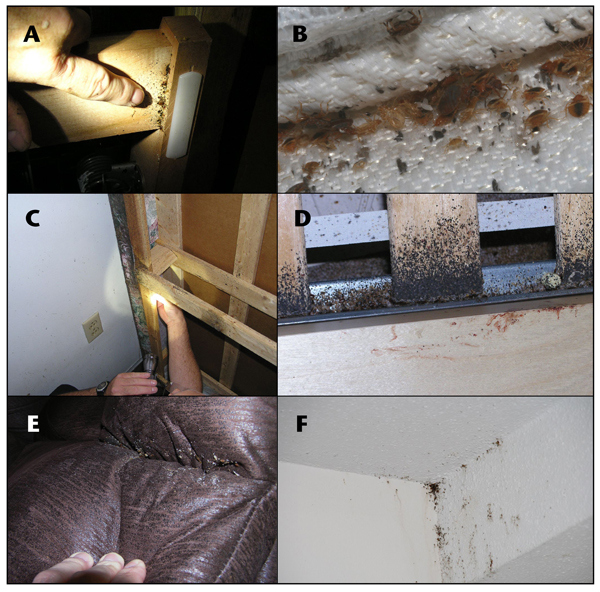
Figure 2. Common harborages of bed bugs: A, behind head of bed; B, mattresses; C, box springs; D, bed frames; E, sofas; F, corners of rooms (photos by A. Romero).
The three-part segmented "beak" is held at rest against the underside of the head where it reaches the bases of the first pair of legs. The beak encloses two pairs of stylets—barbed mandibles that cut the victim's skin—while the needle-like maxillae form a pair of tubes, one for sucking blood and the other for injecting saliva into the wound (Figure 3). Bed bugs prefer feeding on humans, but they also may feed on birds, cats, dogs, and rodents. Female bed bugs have a visible cleft on the right side of the apparent fourth abdominal segment where insemination occurs. Bed bug mating is unique in that the male actually punctures the body wall of his mate, injecting his sperm, a process called "extragenital" or "traumatic" insemination.

Figure 3. Piercing-sucking mouthpart that bed bugs insert into host skin (photo by A. Katsumata and A. Romero).
Over an average 6-month adult lifespan, each female can lay about 200 tiny (1 mm; 1/25 in.) white eggs in batches of 5 to 10, secured to a rough substrate with an adhesive fluid (Figure 4A). Eggs hatch in 6 to 10 days at temperatures of 54 to 98°F (13—37°C). Initially white or straw-colored, a hatchling turns bright red to dark red after feeding. It then retires to a protected crevice to digest its meal, excrete digested blood, and molt.
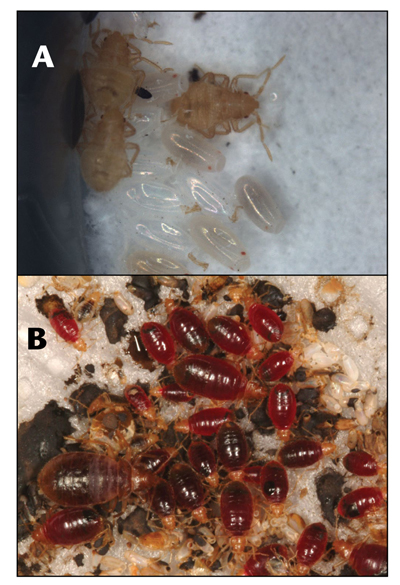
Figure 4. A. Eggs containing embryos and recently hatched first-instar nymphs; B, different instar nymphs recently fed (photos by A. Romero).
Nymphs molt through five progressively larger stages (or instars) in 35 to 48 days, mating very soon after the last molt. Three to four generations can be produced annually. Bed bugs can survive without feeding up to one year. Consequently, it is usually impractical to vacate buildings in the hope of eliminating infestations by starvation. Bed bugs in unoccupied apartments often disperse to nearby units.
Habits of Bed Bugs
Bed bugs typically are nocturnal feeders. They find their hosts by detecting body odors, carbon dioxide, and/or body heat. Bugs may probe their host two to three times before feeding, an act completed in 5 to 10 minutes. Enzymes in the bug's saliva anesthetize the wound while preventing clotting. After feeding, bed bugs return to their refuges: under bedding; in seams, mattresses, box springs (foundations), bed frames, upholstered furniture, nightstands and accompanying knick-knacks, or folds of bed skirts; behind loose wallpaper, curtains, drapes, or pictures and calendars on walls; between loose pieces of flooring; and in or under carpets or rugs (Figure 2). As populations build, bed bug-infested premises may develop a rank "buggy odor," and unhygienic conditions can add to the odor problem. Besides the bugs themselves, other readily visible evidence of bed bug infestations includes:
- smears of dried blood on walls or sheets from crushed bed bugs;
- yellow, brown, or black dots of bug excrement on sheets or pillows or around the edges of mattresses;
- hatched and un-hatched eggs; and
- different sizes of shed skins from nymphs (Figure 5).
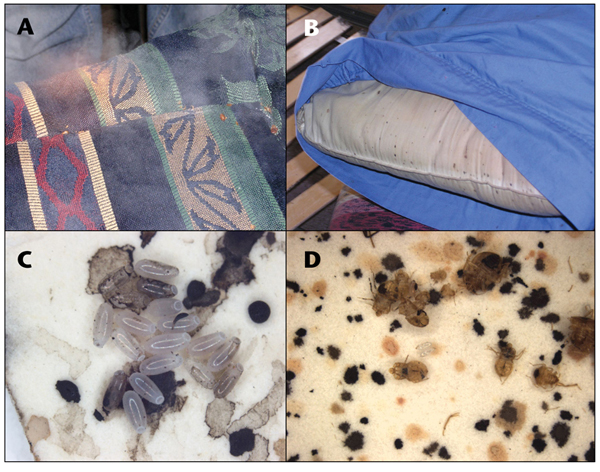
Figure 5. Signs of bed bugs: A, bed bug itself; B, black or brown dots on a pillow (dots are fecal matter of bed bugs); C, unhatched eggs and egg shells; D, molted skins (photos by A. Romero).
Although most of the bed bugs in an infestation may remain in the bed area close to where the host rests, the remaining bugs may wander—crawling up walls, over ceilings, behind plates covering electrical switches, under moldings, and through wall voids from one room to another. They may hide in clothing in closets, which explains the odd circumstances of finding bed bugs in theaters, vehicles (including public transit), and sites collecting or selling used clothing. In mild weather, they may exit an infested room and crawl along gutters or siding to adjoining rooms, apartments, items stored outside of homes or apartments (such as firewood), or, in extreme cases, to different nearby houses.
Health Impacts of Bed Bugs
The importance of bed bugs in public health is due in part to their blood-feeding habits (Figure 6). People vary considerably in their reactions to bed bug feeding. Most victims, but not all, will have circular red bite marks very similar in appearance to mosquito bites (Figure 6B). Usually, there is a tiny red dot in the center of each welt from the penetration of the bug's mouthparts. Reactions to bed bug bites are often seen days or weeks after the actual bite occurs. Lesions caused by bed bug bites usually occur on exposed skin of sleeping victims, such as the face, neck, shoulder, back, and extremities. Reactions may intensify over time with additional exposure to bed bugs.

Figure 6. A, a bed bug feeding on the skin of a human host; B, welts caused by nymph bites (photos by A. Romero).
People should suspect bed bugs if itchy welts appear after a trip, or if these lesions show up after they have acquired used furniture. However, "bites" alone are not diagnostic for bed bugs; victims should submit specimens of the bugs or show other evidence of bed bug infestation for confirmation. University or health department entomologists and county Extension agents are good sources for identification, confirmation, and further information for bed bug victims. People should seek medical attention if skin lesions become extremely itchy. Vigorously scratching welts can cause secondary bacterial infections. A highly sensitized immune system may overreact to even minor, unrelated stimuli as well as bed bug bites. Chronic blood loss and iron-deficiency anemia have been also reported in people continuously exposed to severe bed bug infestations.
The psychological effect of bed bugs should not be underestimated. Presence of bed bugs in such intimate places as beds and bedrooms often creates anxiety. People who are repeatedly bitten may develop nervous behavior, agitation, stress, and sleeplessness. The adverse effects on humans caused by bed bugs have led the Environmental Protection Agency (EPA) and Centers for Disease Control (CDC) to consider this pest of significant public health importance.
Bed bugs also have an economic impact. Infestations often require expensive, ongoing inspections and treatments; disposal and replacement of infested beds and other furnishings; and quarantine of infested areas. In public facilities, they may result in adverse publicity and litigation by persons who are bitten.
Bed Bugs and Disease-Causing Pathogens
The resurgence of a blood-sucking insect, such as the bed bug, raises concerns about the role that these insects may have in transmitting diseases. Whether bed bugs can or cannot transmit diseases to humans is still being investigated. In the last decades, most of the research in this area has been devoted to determining the possibility of bed bugs transmitting disease agents of public health importance, including HIV and hepatitis B. In experimental infections with hepatitis B, bed bugs excreted the virus in feces for several weeks, but transmission was not demonstrated. To date, there is no substantial evidence that bed bugs transmit diseases to humans through bites.
Detecting Bed Bugs
The sooner you detect bed bugs, the better your chances of eradicating the infestation. However, finding bed bugs, especially small populations, can be difficult since the pests are quite small and are especially good at hiding in unusual and sometimes inaccessible places. Educating yourself on what bed bugs and evidence of bed bugs look like is critical.
Plain, unbaited sticky traps are not attractive to bed bugs. Professional canine scent detection can be effective, but it is very expensive; the accuracy of this method can be affected by trainer experience, dog breed, and environmental factors. You can detect bed bugs or monitor the status of your infestation by placing interceptor traps (available commercially) on beds, sofas, and any other piece of furniture with legs (Figure 7). Interceptor traps work by using you, the host, as a lure. The bugs crawl up the sides of the trap and fall into the well at the bottom where they cannot escape. Interceptors are useful to detect bed bugs residing away from bedding areas, but their usefulness is limited if the bugs are harboring in the mattress, box spring, or headboard.
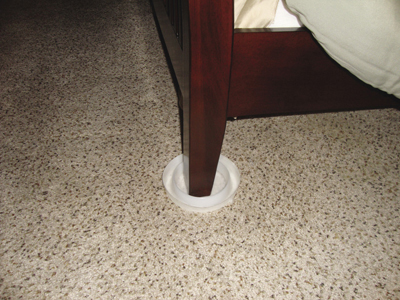
Figure 7. Interceptor traps for bed bugs. Interceptors are placed under furniture legs. Bed bugs trying to reach a sleeping host get trapped in the wells and are not able to escape (photo by A. Romero).
Attempts have been made to develop bed bug monitoring traps that use heat, carbon dioxide, and/or chemical lures. Many of these prototypes have been developed based on generalizations from host cues detected by other blood-feeding insects (e.g., mosquitoes), but their effectiveness has not been scientifically documented.
Mattress or box spring (foundation) bags or encasements can be used as an early detection tool, making it easier to spot any bug leaving the protection of the mattress or box springs (Figure 8).
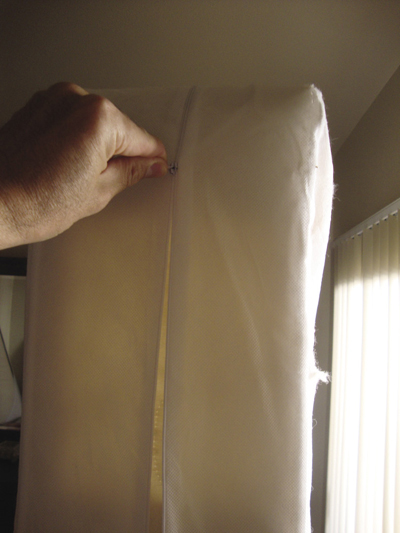
Figure 8. Encasements trap bugs hiding inside mattresses and box springs, and also prevent bed bugs from entering and establishing harborages. Encasements are made of bed bug bite-proof materials (photo by A. Romero).
Preventing Bed Bug Infestations
Avoiding bed bugs is highly recommended, but requires constant vigilance and precautions. Travelers are not guaranteed freedom from bed bugs in hotels or motels, regardless of their apparent cleanliness, reputation, popularity, price, or location. Hotel and motel desk clerks have no practical method of pre-screening check-ins or their luggage. While housekeeping staff and some maintenance people may be trained in detecting and reporting the pests, early infestations are easily overlooked, especially in the daily rush to clean rooms. Routine pest control treatments for cockroaches, ants, crickets, and other structural pests are not aimed at the hidden, unique habitats where bed bugs lurk.
To help avoid bed bugs when traveling, minimize the luggage you bring into your room and keep it off the bed while unpacking or packing. Upon arrival, spend a few minutes carefully examining blankets, sheets, mattress covers, and seams for bed bugs and their debris (described previously); a flashlight is a useful tool. Checking bedside furniture, the headboard, and nearby baseboards, if any, may uncover evidence of bed bugs. However, checking carpets is nearly impossible because most are wall-to-wall and dark colored. Report bed bugs to responsible hotel or motel management immediately, change rooms, or consider changing hotels.
Do not rely on repellents labeled and registered for bed bugs on luggage since these products do not appear to be effective against bed bugs. Upon returning home, launder your clothing right away. Soapy water drowns the bugs; at least 10 to 15 minutes in a hot clothes dryer is also lethal to the pests. Promptly vacuum or brush luggage surfaces and seams before returning bags to storage, preferably away from bedrooms.
Dealing with Infestations: What You Can Do
For infestations discovered in the home, relief from these pests cannot occur fast enough. In most cases, knowledge of bed bug behavior is as necessary as a thorough, patient, multi-pronged approach for successful eradication. In many cases, the homeowner will benefit from the skills and services of an experienced, professional, licensed pest control operator. A do-it-yourself approach is generally not aggressive or thorough enough to deal with bed bugs. Repeated treatments are often necessary since bed bugs can disperse widely, their eggs are often well hidden, and eggs usually are not killed by most contact insecticides.
However, while waiting for the first pest control appointment, you can take a number of steps to further assess the situation, make the pest control operator's job faster and more efficient, and inflict some revenge on the pests. While many of these procedures make the habitat less suitable or comfortable for the pests, bed bugs can rapidly adapt, and their normal reproductive rates will allow them to continue producing offspring without additional intervention. Keep the appointments with the pest control service until the pests are eliminated. Most reputable pest control companies will have both an initial treatment as well as a follow-up visit several weeks later. These follow-up treatments are important components of a bed bug control program. The second insecticide application will deal with insects that might have been missed during the first application, as well as small nymphs that may have hatched from eggs after the first visit. When negotiating a pest control contract, find out the company's policy for follow-up visits.
Discovery of the first (confirmed) bed bug will devolve into a fast and furious, serious and laborious sanitation effort. Keeping a cool head and a positive attitude will help you deal with bed bug infestations. Bed bugs share a number of traits with other blood-feeding arthropods, such as fleas, ticks, and mosquitoes, that we have grown accustomed to. There is no need to panic. Although getting rid of bed bugs may be a challenging process, they can be eradicated from a home. Use and frequently repeat as many of the following steps as possible:
- The first priority will be to strip the bed and launder all bedding, pajamas, and nearby washables in hot, soapy water. Dry these items in a hot dryer.
- Clothes, stored bedding, or towels in nearby closets may be laundered at the same time since dispersing bed bugs are notorious for invading new hiding spots.
- Wash small rugs if possible.
- Homeowners may use their own or rental rug cleaning equipment or hire professionals to shampoo and simultaneously treat larger carpets with appropriately labeled insecticide/rug cleaner combinations.
- A strong vacuum cleaner can remove many bed bugs and their eggs from mattress seams, crevices in foundations, headboards, and edges of baseboards; use the crevice tool or the flexible suction tube. Use a floor tool with a strong rotating brush on carpets and rugs even after they have been washed or otherwise treated for bed bugs. Thorough, frequently repeated vacuuming is desirable, but operators must remember to clean the equipment and destroy any used filter bags immediately after each treatment since the bags can contain live bed bugs that will escape.
- Portable steam cleaners may be used similarly, especially on seams of mattresses and upholstered furniture. However, neither vacuum cleaners nor steam cleaners alone can be used safely or effectively in all locations in the room where bed bugs may hide.
- Eliminate all clutter in the room, including pictures, posters, mirrors, or items stored under beds. Valuable or sentimental items can be placed in plastic bags and either stowed in the freezer for a couple of weeks or placed outdoors in a hot, sunny location for at least 8 hours. Small knick-knacks, stuffed toys, dolls, and other delicate bedside items may be treated similarly.
- For items that will be discarded, put them into garbage bags (if possible) and dispose of the bags immediately in an outdoor dumpster, or take them directly to the dump. For larger items, such as mattresses, box springs, or infested furniture, cut the upholstery or break the items so they cannot be scavenged by unsuspecting people either curbside or at the dump.
- Use a commercially available, no-odor sealant on any hard surfaces with bug hiding places—cracks, crevices, or holes—such as bed frames, nearby furniture, and other items. Seal cracks and crevices in walls (e.g., paneling), molding around doors and windows, and window installations to prevent dispersing or surviving bed bugs from finding harborage.
- Mattress or box spring (foundation) bags or encasements can be used to evaluate the effectiveness of a treatment and better determine when the bed bugs have been eliminated (Figure 8).
Commercial pest control businesses in various parts of the U.S. are offering heat treatments for bed bug-infested rooms or furnishings, similar to treatments already offered for certain wood-infesting organisms. Temperatures of 140°F for 2 hours or 130°F for 3 hours kill most bed bugs and their eggs. The Structural Pest Control Board in California has developed licensing and bonding requirements for companies advertising heat treatments for bed bug control; to date, no heat treatments have been approved for bed bug control in New Mexico.
Use of Insecticides
Appropriately labeled commercially available insecticides, not home remedies, are valuable components of an integrated bed bug control program. Insecticides alone will not eliminate an infestation due to the invasive, secretive behavior of bed bugs. The preliminary sanitary steps listed in the previous section will make the insecticide applicator's job easier and likely more effective, producing results much faster. Both the U.S. EPA and your state Department of Agriculture regulate sales and use of insecticides. These products are formulated to control or aid in the control of pests in certain situations listed on the insecticide label. The insecticide label is considered a legal document that must be read, understood, and followed precisely by the applicator, regardless of whether the product is "conventional" or "organic," or whether the applicator is a licensed professional applicator or member of the general public.
Misusing insecticides poses a greater health risk than the pest itself. Applicators choosing insecticides for bed bug treatments should note which products can be used for crack and crevice treatments, mattresses or upholstered items, wall voids, or other features of the room or home. (Note: Only appropriately licensed applicators can purchase and/or use "Restricted Use" insecticides. The general public cannot purchase or use these products or some others formulated specially for commercial applicators.)
A variety of application sites may require a variety of products or formulations. Some labels may warn of potential staining or avoiding inappropriate, potentially dangerous treatment sites (e.g., electrical connections or equipment). Foggers or "bug bombs" are ineffective for treating bed bugs and can be quite dangerous if misused. Applicators must determine if the appropriate application equipment is available and that the product can be applied safely and adequately according to label directions. Review all safety precautions for the application, preparation of the treatment area, drying and re-entry times, storing of leftover concentrate, and legal disposal of empty containers. If a pest control company has been hired, review these safety and application details with the operator. Don't be afraid to ask questions.
Active ingredients are listed prominently on all insecticide labels. For those interested in insecticidal control of bed bugs, the U.S. EPA posted a highly useful public access website listing over 260 products in a searchable database3. All products listed are currently registered by the EPA for bed bugs, although some may not be marketed in the U.S. In this database, note that some products may be used on mattresses; in cracks, crevices, or voids; or sometimes in whole rooms, but few products can be used in all of these locations. Read product labels carefully for detailed information on application. To prevent confusion of products with similar-sounding names, use the unique EPA registration number for each product to verify the correct selection.
The most common active ingredients in these registered products are pyrethroids and the natural botanic products pyrethrins, which have similar "modes of action," i.e., the mechanism by which an active ingredient produces an effect on a living organism or in a biochemical system. Unfortunately, overuse and inappropriate use of these products has created insecticide resistance in bed bug populations in various parts of the country. In addition, DDT resistance in bed bugs was reported decades ago, and cross resistance between DDT and pyrethroid insecticides is common; therefore, the insecticide category of pyrethrins and pyrethroids may not remain useful for long. This resistance is genetically based and is unlikely to be reversed. Using these products, even at the highest label rates and at the shortest label intervals, can fail to control bed bugs. In some cases, however, the addition of synergists such as piperonyl butoxide enhances the toxicity or extends the residual action of the active ingredient. A handful of appropriately labeled and registered products containing neonicotinoids, pyrroles, or insect growth regulators (IGRs) (e.g., hydroprene, methoprene) are promising alternatives for bed bug control. All of these have different modes of action than those known for pyrethrins and pyrethroids.
To confirm that an insecticide is registered for sale and use in your state, consult your chemical supplier or state Department of Agriculture (pesticide management or registration office), or access the public website for the National Pesticide Information Retrieval System (NPIRS; http://state.ceris.purdue.edu). NPIRS queries at the product level will distinguish general use insecticides from restricted use insecticides. Product labels also will do so plainly. Only appropriately licensed commercial applicators will be able to purchase and use restricted use insecticides
Bed bug control for managers of hotels, motels, barracks, dorms, summer camps, lodges, hospitals, nursing homes, homeless shelters, jails, prisons, and the like is essentially as described previously for homeowners, but obviously more streamlined. Sleeping accommodations are typically more Spartan, and occupants will have relatively few belongings. Managers must detect and control bed bugs quickly to prevent their spread and to maintain facility efficiency, reputation, and occupancy. Constant monitoring of occupants (new and established), sleeping accommodations, commons, and auxiliary service areas is essential. A new bed bug infestation could arrive with just one occupant in one of these facilities. Social service and emergency workers need to take special precautions when entering potentially bed bug-infested premises. Standard procedures include minimizing the number of items brought to the facility, and avoiding sitting and placing coats or other essential items on beds or sofas. When returning home or to offices, workers may want to prioritize washing clothes from their suitcases and sanitizing other items (see Preventing Bed Bug Infestations section).
When insecticide treatments don't produce the desired results, the problem is usually that some of the pests (including eggs) escaped the application or new infested items were brought into the area after the latest treatment. Treatment failure can also be due to insecticide resistance. Recent research confirms that some populations of bed bugs have become highly resistant to certain types of commonly used insecticides. Confirming insecticide resistance requires careful, time-consuming laboratory analysis. Currently, there are numerous registered insecticide products that claim to kill bed bugs when they come into direct contact with the insect, but the applications of these insecticides entail finding places where the bugs are found or tend to hide or crawl.
Bed bugs have been associated with humans for thousands of years, and will no doubt continue to pester us for many more millennia. While it is normal to feel anxiety and apprehension when faced with this uninvited houseguest, it is important to remember that bed bugs CAN be controlled with due diligence, cooperative and complementary pest control treatments, and currently available products. Knowledge is the most valuable tool in preventing bed bug infestations as well as dealing with insects that have become established.
References
Goddard, J., and R. deShazo. 2009. Bed bugs (Cimex lectularius) and clinical consequences of their bites. The Journal of the American Medical Association, 301, 1358—1366.
Hwang, S.W., T.J. Svoboda, I.J. De Jong, K.J. Kabasele, and E. Gogosis. 2005. Bed bug infestations in an
urban environment. Emerging Infectious Diseases,
11, 533—538.
Pinto, L.J., R. Cooper, and S.K. Kraft. 2007. Bed bugs handbook: The complete guide to bed bugs and their control. Mechanicsville, MD: Pinto & Associates, Inc.
Potter, M.F. 2006. The perfect storm: An Extension view on bed bugs. American Entomologist, 52, 102—104.
Potter, M.F. 2008. The history of bed bug management. Pest Control Technology, Bed bug supplement: Lessons from the past.
Reinhardt, K., and M.T. Siva-Jothy. 2007. Biology of the bed bugs (Cimicidae). Annual Review of Entomology, 52, 351—374.
Romero, A., M.F. Potter, D. Potter, and K.F. Haynes. 2007. Insecticide resistance in the bed bug: A factor in the pest's sudden resurgence? Journal of Medical Entomology, 44, 175—178.
Romero, A. 2009. Biology and management of the bed bug, Cimex lectularius L. (Heteroptera: Cimicidae) [Doctoral dissertation]. Lexington: University of Kentucky.
Romero, A. 2011. Moving from the old to the new: Insecticide research on bed bugs since the resurgence. Insects, 2, 210—217.
Usinger, R.L. 1966. Monograph of Cimicidae (Hemiptera-Heteroptera). College Park, MD: Thomas Say Foundation.
Footnotes
1"Sleep tight" is a commonly used phrase in many parts of the English-speaking world, usually said at bedtime in the form of the rhyme, "Good night, sleep tight, don't let the bedbugs bite."
2Cimex lectularius, L. (Hemiptera: Cimicidae)
3https://cfpub.epa.gov/oppref/bedbug/. This website is routinely updated to reflect currently labeled, registered products.

Carol A. Sutherland is an Extension Entomologist at New Mexico State University and also State Entomologist for the New Mexico Department of Agriculture. Dr. Sutherland makes numerous presentations annually on basic and applied entomology to New Mexico’s Master Gardener groups, pest control workshops, and other events. She identifies insects for Extension agents, farmers, ranchers, pest control operators, and the general public.
To find more resources for your business, home, or family, visit the College of Agricultural, Consumer and Environmental Sciences on the World Wide Web at pubs.nmsu.edu
Contents of publications may be freely reproduced for educational purposes. All other rights reserved. For permission to use publications for other purposes, contact pubs@nmsu.edu or the authors listed on the publication.
New Mexico State University is an equal opportunity/affirmative action employer and educator. NMSU and the U.S. Department of Agriculture cooperating.
Printed and electronically distributed August 2013 Las Cruces, NM.


